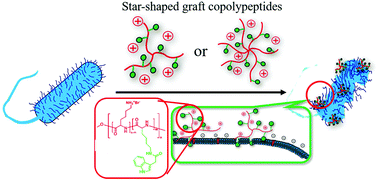Star-shaped polypeptides exhibit potent antibacterial activities†
Abstract
Peptide-based biomaterials are a promising class of antimicrobial agents that work by physically damaging bacterial cell membranes rather than targeting intracellular factors, resulting in less susceptibility to drug resistance. Herein we report the synthesis of cationic, star-shaped polypeptides with 3 to 8 arms and their evaluation as antimicrobial agents against different types of bacteria. The effects of the arm number and side chain group on their antimicrobial activities were systematically investigated. Compared to their linear counterparts, these star-shaped polypeptides exhibited potent antibacterial activity (which may involve adhesion and disruption processes). The increase of the arm number can efficiently increase the antibacterial activities up until 8 arms, which did not exhibit further improvement of antibacterial activities. Poly(L-lysine) (PLL) modified with an indole group (PLL-g-indo) exhibited the best antibacterial activity among all grafted copolypeptides and improved cytotoxic selectivity towards pathogens over mammalian cells without compromising their hemolytic activities. In vivo studies showed that the star-shaped PLL-g-indo can effectively suppress Enterohaemorrhagic E. coli (EHEC) infection and attenuate the clinical symptoms in mice, suggesting that they are promising antimicrobial agents.



 Please wait while we load your content...
Please wait while we load your content...